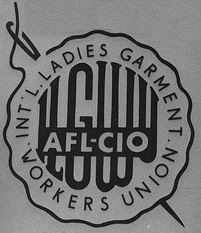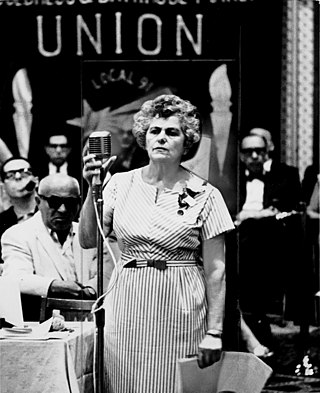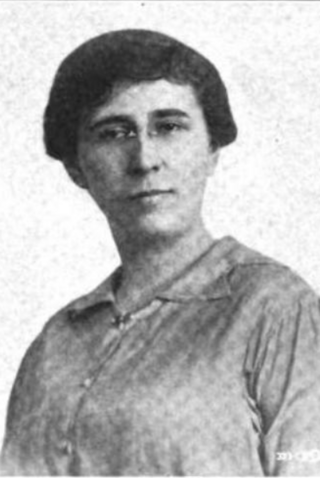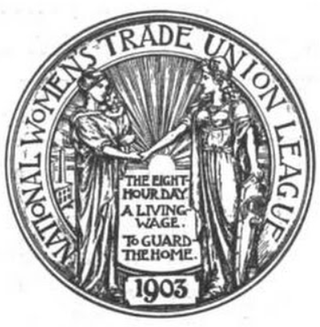Related Research Articles

Sidney Hillman was an American labor leader. He was the head of the Amalgamated Clothing Workers of America and was a key figure in the founding of the Congress of Industrial Organizations and in marshaling labor's support for President Franklin D. Roosevelt and the New Deal coalition of the Democratic Party.

David Dubinsky was a Belarusian-born American labor leader and politician. He served as president of the International Ladies Garment Workers Union (ILGWU) between 1932 and 1966, took part in the creation of the CIO, and was one of the founders of the American Labor Party and the Liberal Party of New York.

The International Ladies' Garment Workers' Union (ILGWU), whose members were employed in the women's clothing industry, was once one of the largest labor unions in the United States, one of the first US unions to have a primarily female membership, and a key player in the labor history of the 1920s and 1930s. The union, generally referred to as the "ILGWU" or the "ILG", merged with the Amalgamated Clothing and Textile Workers Union in the 1990s to form the Union of Needletrades, Industrial and Textile Employees (UNITE). UNITE merged with the Hotel Employees and Restaurant Employees Union (HERE) in 2004 to create a new union known as UNITE HERE. The two unions that formed UNITE in 1995 represented 250,000 workers between them, down from the ILGWU's peak membership of 450,000 in 1969.
Amalgamated Clothing Workers of America (ACWA) was a United States labor union known for its support for "social unionism" and progressive political causes. Led by Sidney Hillman for its first thirty years, it helped found the Congress of Industrial Organizations. It merged with the Textile Workers Union of America (TWUA) in 1976 to form the Amalgamated Clothing and Textile Workers Union (ACTWU), which merged with the International Ladies' Garment Workers' Union in 1995 to create the Union of Needletrades, Industrial and Textile Employees (UNITE). UNITE merged in 2004 with the Hotel Employees and Restaurant Employees Union (HERE) in 2004 to create a new union known as UNITE HERE. After a bitter internal dispute in 2009, the majority of the UNITE side of the union, along with some of the disgruntled HERE locals left UNITE HERE, and formed a new union named Workers United, led by former UNITE president Bruce Raynor.

Clara Lemlich Shavelson was a leader of the Uprising of 20,000, the massive strike of shirtwaist workers in New York's garment industry in 1909, where she spoke in Yiddish and called for action. Later blacklisted from the industry for her labor union work, she became a member of the Communist Party USA and a consumer activist. In her last years as a nursing home resident she helped to organize the staff.

Rose Pesotta (1896–1965) was an anarchist, feminist labor organizer and vice president within the International Ladies' Garment Workers' Union.

The New York shirtwaist strike of 1909, also known as the Uprising of the 20,000, was a labour strike primarily involving Jewish women working in New York shirtwaist factories. It was the largest strike by female American workers up to that date. Led by Clara Lemlich and the International Ladies' Garment Workers' Union, and supported by the National Women's Trade Union League of America (NWTUL), the strike began in November 1909.
The Chinese Staff and Worker's Association (CSWA) is a nonprofit, nonpartisan workers' rights organization based in New York City which educates and organizes workers in the United States so that they may improve their working conditions. It primarily assists workers in restaurants, the garment and construction industries, although it is active among workers in a variety of professions. The organization serves workers from all backgrounds, most of its members are Chinese and most of its efforts directed at employers in Chinatown.

Fannia Mary Cohn was a leading figure in the International Ladies' Garment Workers' Union (ILGWU) during the first half of the 20th century. She is remembered as one of the pioneers of the workers' education movement in the United States and as a prolific author on the theme of trade union education.
Benjamin "Ben" Schlesinger was a Lithuanian-born American trade union official and newspaper office manager. Schlesinger is best remembered as the nine-time president of the International Ladies Garment Workers Union (ILGWU), serving from 1903 to 1907, again from 1914 to 1923, and finally from 1928 until his death in 1932. He was also the managing editor of The Jewish Daily Forward from 1907 to 1912 and the resident manager of the Chicago edition of that publication beginning in 1923.
Jay Mazur is an American labor leader. He was the last president of the International Ladies' Garment Workers' Union (ILGWU), serving from 1986 to 1995, and the first president of the Union of Needletrades, Industrial and Textile Employees (UNITE), serving from 1995 to 2001.
Charlotte Duncan Smith Graham was an American seamstress and labor organizer. She led major strikes in Dallas, Texas and elsewhere against the clothing manufacturing industry, and was an active member of labor unions.
The Los Angeles Garment Workers strike of 1933 is considered to be one of the most influential strikes in Los Angeles after the passing of the New Deal. The strike is known for being one of the first strikes where Mexican immigrant workers played a prominent role. The garment workers strike occurred in the fall of 1933 in the downtown Garment District in Los Angeles, California. Leaders of the strike, including Rose Pesotta and other members of the International Ladies Garment Workers Union (ILGWU), organized the strike to be culturally orientated in order to include Mexican immigrant workers to fight for union recognition in the garment industry.
Xiaolan Bao was a Burmese American historian, educator, and researcher. She was the author of the 2001 book, Holding Up More Than Half the Sky: Chinese Women Garment Workers in New York City, which is regarded as a breakthrough work of Asian American labor history. Her academic field was Chinese and Chinese American women's history and labor history.
Min Matheson was a labor organizer for the International Ladies’ Garment Workers Union (ILGWU) in northeastern Pennsylvania silk and textile mills who successfully stood up to organized crime. Min was also a founding member of the National Organization for Women.
May Ying Chen is an American labor organizer and advocate for immigrant workers. Before retiring in 2009, she was an officer and founding member of the AFL–CIO's Asian Pacific American Labor Alliance (APALA), and the International Vice President of UNITE HERE.
Katie Quan is a senior fellow at the UC Berkeley Center for Labor Research and Education, a former chair of the center, and a former labor organizer. In 1982, she was one of the organizers of the historic garment workers' strike in New York City's Chinatown.

Women in labor unions have participated in labor organizing and activity throughout United States history. These workers have organized to address issues within the workplace, such as promoting gender equality, better working conditions, and higher wages. Women have participated in unions including the Collar Laundry Union, the WTUL, the IWW, the ILGWU, and the UAW.
National Dollar Stores, Ltd., formerly known as China Toggery and Sang Lee Dry Goods, was a Chinese American-owned dry goods store chain that operated primarily in the western United States from 1903 to 1996. Founded by Joe Shoong in 1903 and incorporated in 1921, the National Dollar Stores were the first retail chain on the West Coast and one of the largest Chinese American-owned retail chains in U.S. history.
References
Citations
Bibliography
- Bao, Xiaolan (2001). Holding Up More Than Half the Sky: Chinese Women Garment Workers in New York City, 1948-92. University of Illinois Press. ISBN 9780252026317.
- Chan, Huiying B. (2019). "How Chinese American Women Changed U.S. Labor History". Open City. Asian American Writers Workshop.
- Quan, Katie (2009). "Memories of the 1982 ILGWU Strike in New York Chinatown" (PDF). Amerasia Journal. 35 (1): 76–91. doi:10.17953/amer.35.1.l704mpj32652q227. S2CID 146765009.
- "The Chinatown Struggle of 1982". Cornell University ILR School.